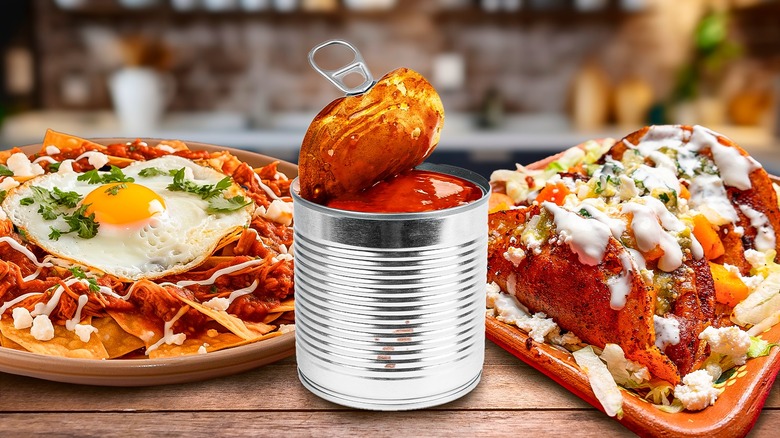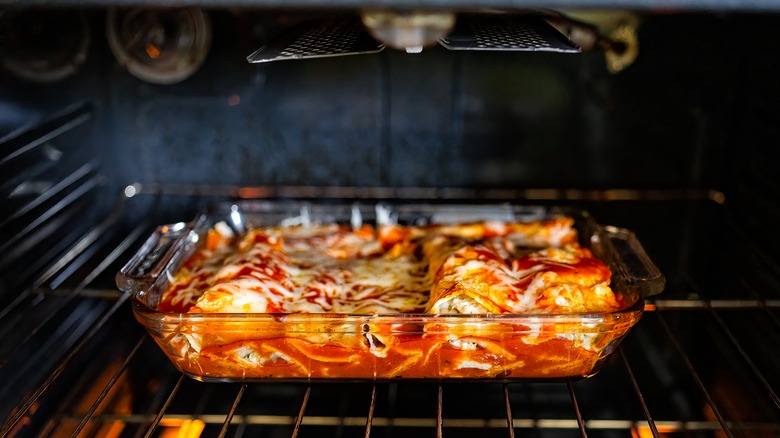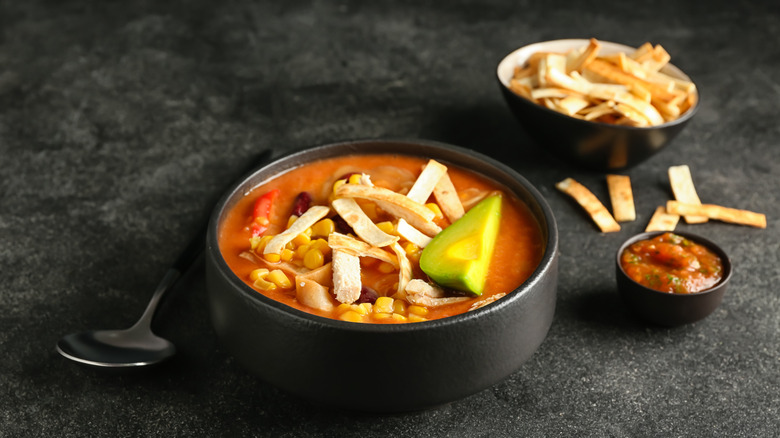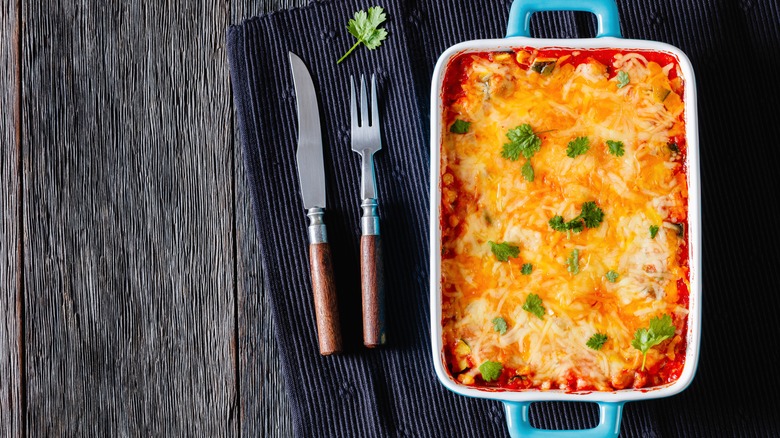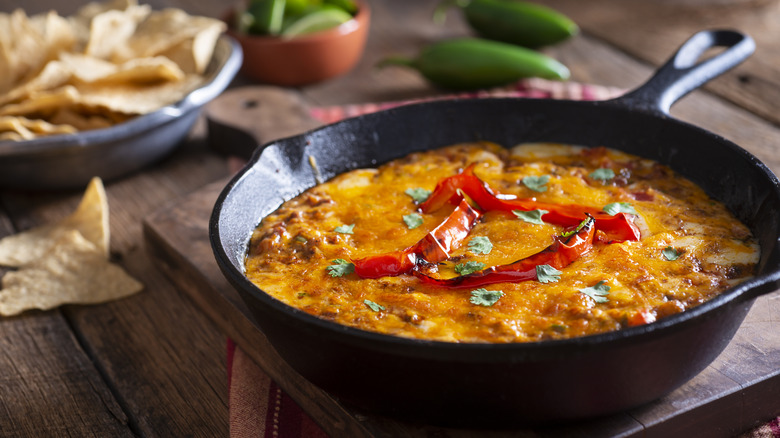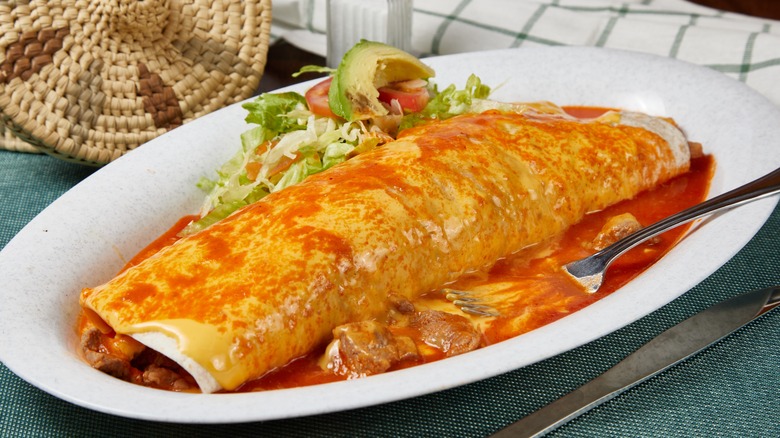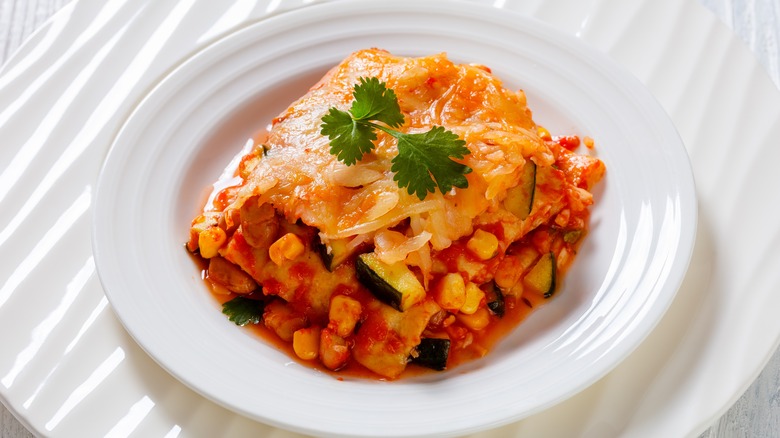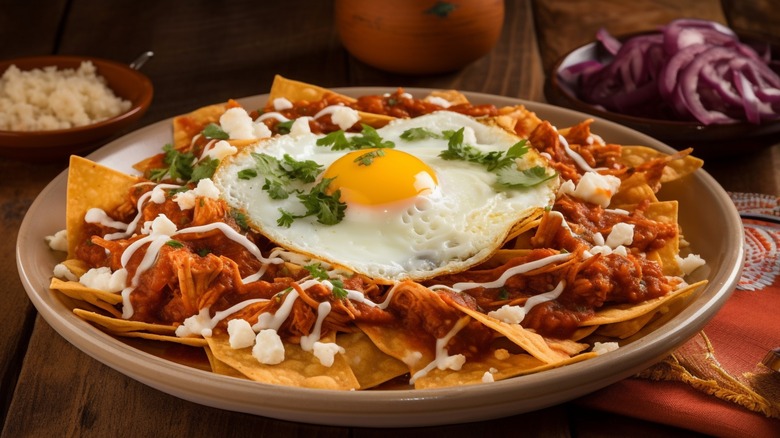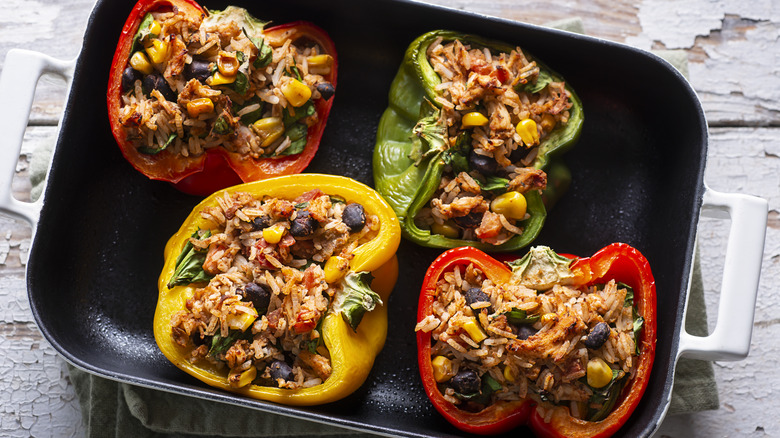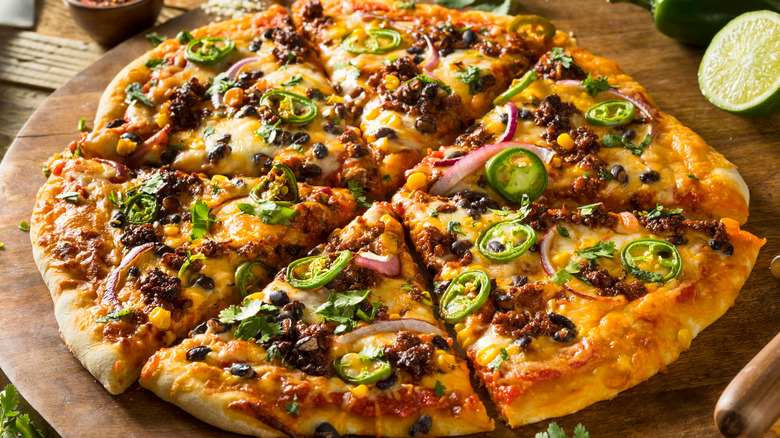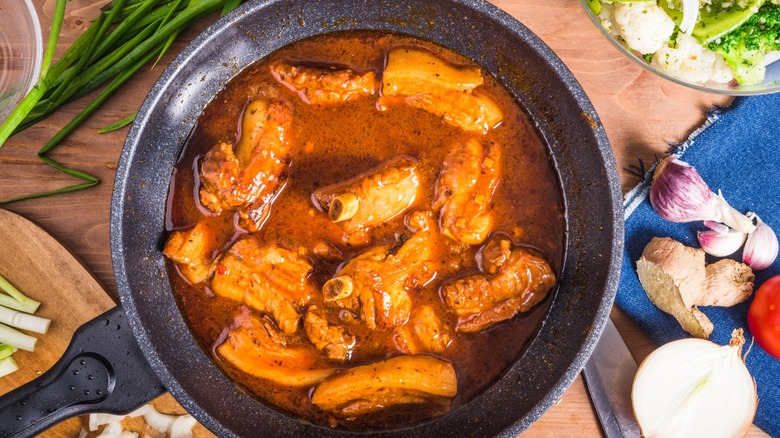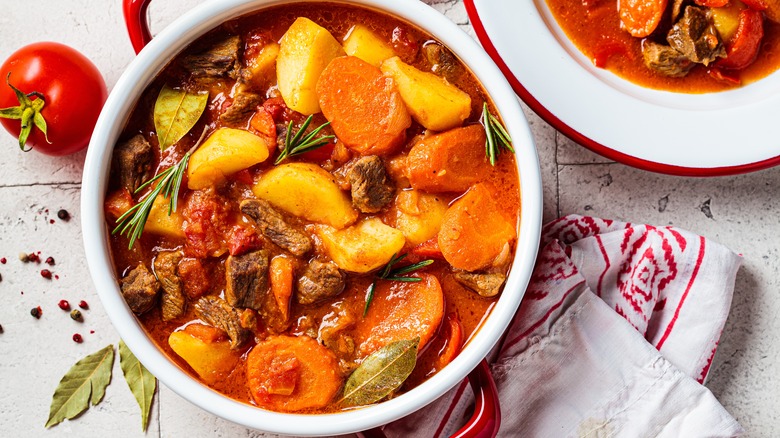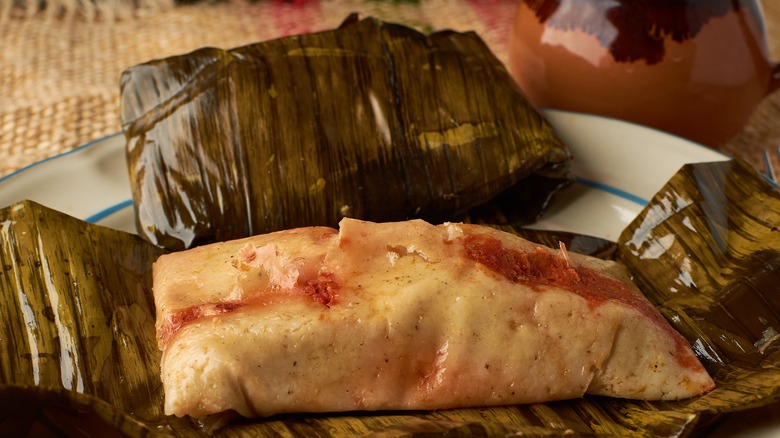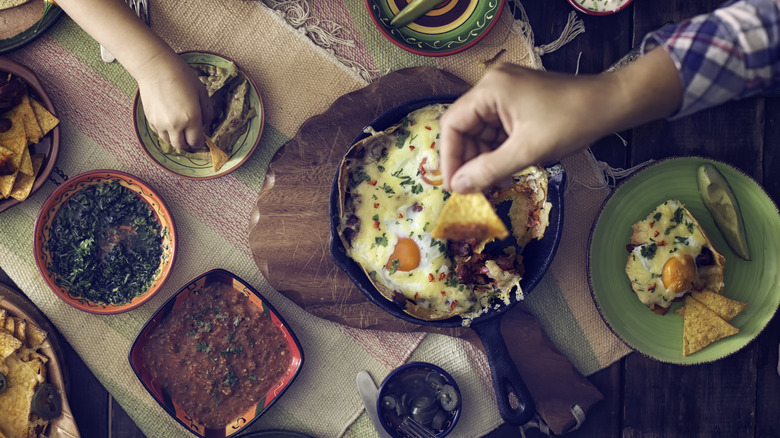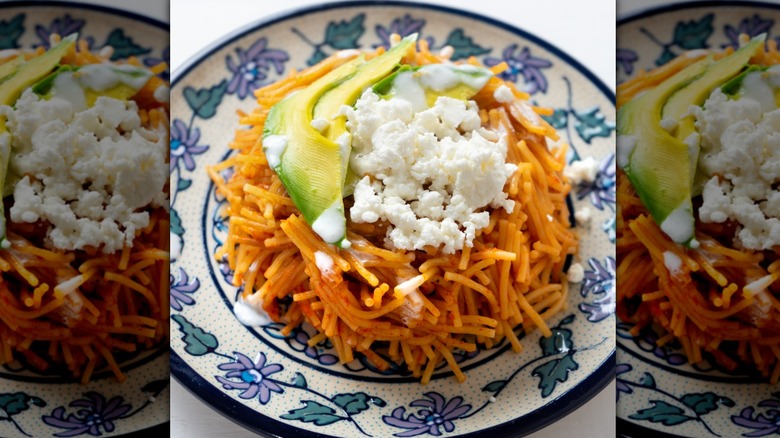14 Ways To Use Canned Enchilada Sauce
Enchilada sauce, both red and green, is a slow-simmered perfect melding of flavors that include chili, toasted spices, and stock. Dried chilies are roasted, rehydrated, and added with toasted spices to a blender before getting a final simmer with the stock. Green enchilada sauce uses fresh herbs and chilies as well. But what happens when you don't have several hours to devote to perfecting your own signature sauce?
Canned enchilada sauce, that humble staple in the international food aisle of your grocery store, is a versatile ingredient that works for more than just its namesake. If you have a hard time convincing yourself to use it straight from the can, it's easy to zhuzh up canned enchilada sauce. The easiest way to make canned enchilada sauce taste more homemade is to make a roux with flour and butter, add a little stock to loosen it up, then pour in your can of enchilada sauce. Bring this to a boil until it thickens slightly, then use it in your dish.
To bump up the flavor of green enchilada sauce, a handful of fresh herbs, garlic, and fresh chili peppers helps brighten the flavor. Both red and green sauces could also do with a squeeze of lime, and red sauce loves chipotle peppers in adobo added for more depth of flavor. Once you've upgraded your canned enchilada sauce, it's time to cook. Here are a few ways to use it — starting at the beginning.
1. Try out traditional enchiladas
The most obvious use for canned enchilada sauce is to make traditional enchiladas. This should not be seen as an easy way out. Enchiladas date back to the Aztec empire when tortilla-wrapped foods filled with chili paste were popular. The Spanish conquistadors loved this eating style and added other fillings, such as pork, cheese, and chicken. Enchilada sauce takes a long time to make, and opting for the canned variety allows you to customize and build a delicious, creative filling.
There are two ways to think about making traditional enchiladas. Some cooks fill each tortilla with meat, cheese, or beans before rolling them up, placing them in a baking dish, and covering them with sauce. Enchiladas can be filled with beef or other meat, or you can opt for a vegetarian version. If you like more sauce, try a variation on this theme. Before filling your tortillas, dip each one in enchilada sauce. Add filling, roll, and bake as usual. This makes for a saucier final dish. If you're avoiding gluten, you can still enjoy enchiladas. Corn and flour tortillas are both at home in this dish.
2. Whip up some enchilada soup
People across the globe eat hot, spicy food year-round, but there's something about cold weather that makes soup the perfect choice. Canned enchilada sauce is an excellent addition to a spicy, savory soup or stew, with nearly infinite variations.
Start as you would any delicious soup by sautéing onions and garlic. This first step alone adds depth of flavor that automatically lifts the quality of any ingredients that come next. The ingredient list is pretty short if you want to make a traditional enchilada soup. Add chicken or vegetable broth (although homemade beef stock is also delicious), and simmer beans, corn, and cooked chicken or turkey. You can use green or red enchilada sauce for this simple dish.
Want something that feels a bit more substantial? Expand your ingredient list to include beef and potatoes (russet or sweet potatoes both work), and use red enchilada sauce for a variation of beef stew with a kick. Whichever variation you try, serve your soup with tortilla strips, sour cream, shredded cheese, and fresh lime.
3. Get spicy with enchilada casserole
Casseroles are another cold-weather food that make a welcome addition to family gatherings and potlucks. They are largely hands-off, which means they're great for busy weeknight meals. You can use flour or corn tortillas in an enchilada casserole. Layer tortillas, meat, beans, cheese, and vegetables in a casserole dish. Good vegetables to try include zucchini, corn, and even hearty greens like kale. Add canned enchilada sauce between each layer, and bake until heated through.
Enchilada casseroles should rest for at least 15 minutes when pulled from the oven. This gives the layers time to firm up and makes for easier serving. Serve with traditional enchilada accompaniments (i.e., sour cream, lime, fresh cilantro). For even more convenience, double the recipe and make two casseroles. Bake one, then freeze the other. Wrap the layered but unbaked enchilada casserole in plastic wrap and aluminum foil. Label with baking instructions and freeze for up to six months.
4. Dive into enchilada dip
You don't need to wait for game day to throw down a spicy, creamy snack. Any time is a good time to set out a delicious dip. Enchilada dip is so simple to make and satisfies that craving for spicy, salty, and creamy all in one go.
You need one full can of enchilada sauce, either straight from the can or doctored to deepen the flavor. Mix the sauce with softened cream cheese, shredded chicken, and black beans (add corn if you like a contrasting sweetness). This can all be heated in a saucepan before serving or placed in an oven-proof dish, topped with sharp shredded cheddar, and baked until the top is brown and bubbling.
Serve this enchilada dip warm with tortilla chips. You can also add a tablespoon or two of sour cream to loosen the dip and serve with vegetables. Vegetables naturally forming a scoop work best here: Think endive, celery, chunks of green pepper, or broccoli florets.
5. Get saucy with wet burritos
It might seem impossible to improve upon the perfection of a burrito. After all, what could be better than a tender flour tortilla wrapped around copious fillings like beans, rice, meat, and guac? This is hand-held eating at its finest, delivered snugly in an aluminum foil blanket.
But when you're ready to try something different, consider a wet burrito. All of the delicious fillings you crave inside a burrito blanket, only this time smothered with enchilada sauce, sprinkled with cheese, and broiled until the cheese bubbles and drips down the sides. Yes, you will need a fork to eat your burrito, but you will not be sad at the loss of convenience or portability. Think of this as gilding the lily — adding enchilada sauce to make a wet burrito elevates both the burrito and the sauce.
Concerned about your wet burrito getting soggy and falling apart? The secret is to assemble your burrito and then toast it before topping it with sauce. Heat oil in a skillet, then toast your burrito to get it crispy before spooning on the sauce and baking in the oven. This prevents your flour tortilla from turning into a soggy mess.
6. Explore Mexican lasagna fusion cuisine
Fusion cuisine brings together sometimes disparate food traditions to create something altogether startling and new. Mexican lasagna is one such combination. After all, enchilada sauce is a mother sauce in Mexican cuisine just as tomato sauce is a mother sauce in Italian cuisine. Swapping one for the other makes perfect sense — with a few adjustments when you do.
Prepare your lasagna noodles as usual. Assemble your dish in order: sauce, noodles, ricotta cheese, meat, or vegetables, then more sauce before beginning the next layer. Finish the top with a sprinkling of Colby jack or cheddar cheese. If you opt for beef Mexican lasagna, season it with taco seasoning (homemade with some smokiness or store-bought). Cover with foil and bake for 45 minutes, then remove the foil for 10-15 minutes and bake until the cheese is browned and bubbly.
Let the lasagna sit for a few minutes before serving. Mexican cuisine is known for its freshness and bright flavors, so serve this lasagna with chopped fresh tomato, diced red onion, a squeeze of lime, and fresh cilantro.
7. Layer up some chilaquiles
Chilaquiles is a classic late-night snack, morning-after hangover cure, or midday chef's breakfast. Regardless of who you are or when you eat it, this dish was invented as a way to use up tortillas that were past their prime. These days, some cooks use tortilla chips as their base, but it's traditional to utilize stale tortillas.
Start by cutting flour or corn tortillas into triangles or strips and frying them in a little oil until they're crispy. If you're using veggies, broil them until they have a nice char while you fry your tortillas in batches. Move the chips to dry on paper towels as you work. When all of your chips are crispy, add them back to the skillet and pour your enchilada sauce over them. Cook for a few minutes until each chip is coated. Plate up your chilaquiles, starting with the chips on the bottom and layering on your vegetables.
After that, the sky's the limit. Add shredded chicken or ground beef, black beans for a vegetarian version, and top with a fried egg (for breakfast chilaquiles or any time). Delicious garnishes can include thinly sliced radish, pickled onions, shredded cheese, sour cream, avocado, and chopped fresh cilantro.
8. Stuff some peppers
There are a few foods that are universal with slight variations across global cuisines. Bread is one of those foods, and another more surprising food is stuffed peppers. Seems like every culinary tradition has a version of whole peppers stuffed and baked until the pepper is soft and the flavors of the stuffing come together.
Use your canned enchilada sauce to bring this tradition to Mexican cuisine. To speed up your baking time, you'll want to properly prepare your peppers for stuffing. You can do this in one of three ways. The first and most common is to wash the peppers, cut off the top and remove the seeds, and boil them in a covered pot until they are tender. Another way is to bake the unfilled peppers while you prep the stuffing, then fill them and continue baking until they are ready. Finally, if you are really pressed for time, place the cleaned peppers in the microwave for 2-3 minutes to soften them before baking.
The filling in enchilada stuffed peppers should include a starch and some kind of protein, plus cheese and half the can of enchilada sauce. Good combinations include rice and beans or rice, beans, and meat. Stuff your bell peppers with the mixture, and place them upright in a baking dish. Pour more sauce over the top and bake until ready.
9. Fire up the pizza oven
If you're the kind of person who thinks every night should be pizza night, it's possible that you have already experimented with unusual pizza combinations. Why not add Mexican pizza to your rotation?
If you have plenty of time, ensure the success of your endeavor by making your own pizza crust. This is one of those baking projects that does double duty if you make a double batch and freeze half the dough. Homemade pizza crust is generally superior to anything you can purchase in a store, but if time is tight, use your favorite store-bought crust. You must bake the crust beforehand if you prefer to buy pre-made dough and roll it yourself.
When your crust is fully baked, take the time to tart up your enchilada sauce before spreading it on your pizza crust. A simple addition of smoked chipotle chili powder is a perfect addition. When your sauce is evenly spread across the crust, now's the time to get creative. You can stick with traditional mozzarella cheese and bake as usual, or feel free to experiment with more toppings pulled from Mexican cuisine. Think black beans, fresh corn, and jalapeños. You can even swap out the mozzarella cheese for Colby jack or cheddar. Bake until the cheese is bubbly, serve with fresh avocado and chopped cilantro, and pass the hot sauce.
10. Incorporate it into your Sunday braise
The traditional Sunday braise takes the toughest large cuts of meat and simmers them for hours. This long, slow cook in a deeply flavored liquid breaks down tough muscle tissue until it becomes meltingly soft and flavorful. Few things in the world are as lovely as walking into your home at the end of the day to a house scented with the smell of savory dinner.
But you don't need to wait for a traditional Sunday braise to experience the beauty of being greeted by your dinner when you enter your door. Slow cookers and an Instant Pot can deliver the same delicious result, and enchilada sauce makes their job even easier. The acid in enchilada sauce helps further break down tough meat and imparts a bright contrast in flavor.
To braise with enchilada sauce, you'll need a can or two of sauce, plus additional liquid (stock works best here). The amount of liquid you need depends on the size of the cut of meat, but you'll want it to be immersed in the braising liquid. Add any root vegetables you like to the pot, too. These will flavor the meat even further. And don't throw out the braising liquid. You can freeze it in 1- or 2-cup portions for later use.
11. Make your mash memorable
Remember that braising liquid you froze? Grab a portion from the freezer and defrost it to make enchilada sauce gravy. Gravy traditionally uses beef or chicken stock to loosen up a roux. The resulting gravy is then seasoned with salt and pepper, sage, and any other fresh or dried herbs you prefer. Enchilada sauce gravy is made the same way, only in this case, you'll use a can of enchilada sauce, along with the brazing liquid if you have it.
Start by making a roux in a one-to-one ratio of fat to flour. Cook the flour and melted fat until it smells nutty, then add your can of enchilada sauce. At this point, the gravy will be quite thick. You can thin it with the braising liquid from your enchilada Sunday braise or add any type of stock you like. Season with salt and pepper, then get creative with your flavor profile. Cumin adds a nice earthy note, and any chili powder brings more heat.
Use your enchilada sauce gravy over mashed potatoes. Crispy fried chicken sandwiches with this gravy as a condiment are delicious, as are pulled pork or ground beef sloppy joe-style sandwiches. Enchilada sauce gravy is also a good base for a spicy Mexican beef stew.
12. Tart up your tamales
Tamales, those labor-intensive, delicious steamed cakes of corn, plain or filled with meat or beans, are the perfect canvas on which to paint your enchilada sauce. Corn is a receptive base for various flavors, and the relatively neutral flavor plays well with other strong tastes.
If you've made your own, you know fresh out of the steamer is the best way to eat tamales. These wrapped bundles of love should be opened when you're ready to eat. If you've picked up refrigerated or frozen tamales, warm them before you eat. Otherwise, they will be dry, crumbly, and unpleasant to eat.
Once your tamales are warm, serve them drenched in heated enchilada sauce. This sauce can be doctored to boost the flavor or eaten straight from the can. If you prefer a more subtle flavor, green enchilada sauce is lighter and will not mask the flavor of the corn entirely. But if you are the kind of eater who sees corn as a conveyance for bold, spicy flavor, red enchilada sauce is your best bet.
13. Put a spin on shakshuka
Shakshuka, a skillet dish of tomatoes, onions, and peppers with just-set eggs swimming deliciously on the top, originated in North Africa. The word shakshuka refers to the mixing together of these ingredients.
Transform this traditional Tunisian dish into something south of the border with enchilada sauce. Start by sautéing onions and garlic. If you'd like vegetables or tomatoes in your Mexican shakshuka, add them with a can of enchilada sauce, and simmer until the vegetables soften and the tomatoes break down. When it is nearly time to eat, crack eggs into the sauce. The number of eggs you put into your dish depends on how large the vessel is and how many people you are serving. Cover the skillet, and cook until the egg whites are set. A key feature of shakshuka is a runny yolk, so do not cook until the yolk is solid.
When the eggs are ready, sprinkle the top with cotija cheese. Shakshuka is usually served with flatbreads, but you can also pass tortillas or tortilla chips. Don't forget the fresh avocado, squeeze of lime, or chopped cilantro.
14. Splash it on spaghetti
Lasagna is not the only pasta dish where enchilada sauce can be the star. Nearly any type of pasta can be adapted and served with this spicy Mexican sauce. Consider stuffed shells or manicotti. These dishes become more intensely flavored when covered with enchilada sauce. Add diced chicken, fresh diced vegetables, and enchilada sauce to any shape of pasta and top with cotija or queso fresco.
If you feel like the flavor of enchilada sauce might be too much over plain pasta, consider turning it into a creamy sauce. For a simple, weekday one-pot pasta dish, cook ground beef with cumin, garlic powder, and onion powder in a skillet and drain the fat. Add one can of enchilada sauce, 2 cups of stock, and one bag of pasta (around 8 ounces uncooked). Cook until the pasta is tender, then stir in corn and a few chunks of cream cheese just before you remove the pan from the heat. Stir until the cream cheese is smooth and incorporated, and serve with chopped green onion, black olives, and fresh cilantro.
